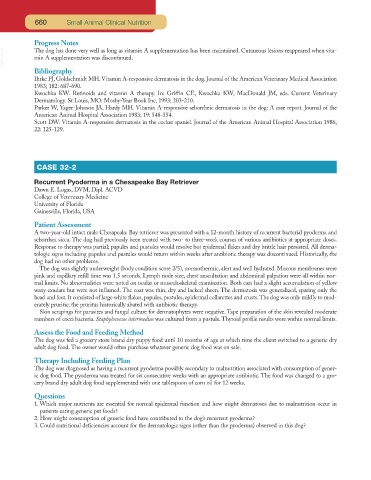Page 638 - Small Animal Clinical Nutrition 5th Edition
P. 638
660 Small Animal Clinical Nutrition
Progress Notes
VetBooks.ir The dog has done very well as long as vitamin A supplementation has been maintained. Cutaneous lesions reappeared when vita-
min A supplementation was discontinued.
Bibliography
Ihrke PJ, Goldschmidt MH.Vitamin A-responsive dermatosis in the dog. Journal of the American Veterinary Medical Association
1983; 182: 687-690.
Kwochka KW. Retinoids and vitamin A therapy. In: Griffin CE, Kwochka KW, MacDonald JM, eds. Current Veterinary
Dermatology. St Louis, MO: Mosby-Year Book Inc, 1993; 203-210.
Parker W, Yager-Johnson JA, Hardy MH. Vitamin A-responsive seborrheic dermatosis in the dog: A case report. Journal of the
American Animal Hospital Association 1983; 19: 548-554.
Scott DW. Vitamin A-responsive dermatosis in the cocker spaniel. Journal of the American Animal Hospital Association 1986;
22: 125-129.
CASE 32-2
Recurrent Pyoderma in a Chesapeake Bay Retriever
Dawn E. Logas, DVM, Dipl. ACVD
College of Veterinary Medicine
University of Florida
Gainesville, Florida, USA
Patient Assessment
A two-year-old intact male Chesapeake Bay retriever was presented with a 12-month history of recurrent bacterial pyoderma and
seborrhea sicca. The dog had previously been treated with two- to three-week courses of various antibiotics at appropriate doses.
Response to therapy was partial; papules and pustules would resolve but epidermal flakes and dry brittle hair persisted. All derma-
tologic signs including papules and pustules would return within weeks after antibiotic therapy was discontinued. Historically, the
dog had no other problems.
The dog was slightly underweight (body condition score 2/5), normothermic, alert and well hydrated. Mucous membranes were
pink and capillary refill time was 1.5 seconds. Lymph node size, chest auscultation and abdominal palpation were all within nor-
mal limits. No abnormalities were noted on ocular or musculoskeletal examination. Both ears had a slight accumulation of yellow
waxy exudate but were not inflamed. The coat was thin, dry and lacked sheen. The dermatosis was generalized, sparing only the
head and feet. It consisted of large white flakes, papules, pustules, epidermal collarettes and crusts.The dog was only mildly to mod-
erately pruritic; the pruritus historically abated with antibiotic therapy.
Skin scrapings for parasites and fungal culture for dermatophytes were negative. Tape preparation of the skin revealed moderate
numbers of cocci bacteria. Staphylococcus intermedius was cultured from a pustule. Thyroid profile results were within normal limits.
Assess the Food and Feeding Method
The dog was fed a grocery store brand dry puppy food until 10 months of age at which time the client switched to a generic dry
adult dog food. The owner would often purchase whatever generic dog food was on sale.
Therapy Including Feeding Plan
The dog was diagnosed as having a recurrent pyoderma possibly secondary to malnutrition associated with consumption of gener-
ic dog food. The pyoderma was treated for six consecutive weeks with an appropriate antibiotic. The food was changed to a gro-
cery brand dry adult dog food supplemented with one tablespoon of corn oil for 12 weeks.
Questions
1. Which major nutrients are essential for normal epidermal function and how might dermatoses due to malnutrition occur in
patients eating generic pet foods?
2. How might consumption of generic food have contributed to the dog’s recurrent pyoderma?
3. Could nutritional deficiencies account for the dermatologic signs (other than the pyoderma) observed in this dog?

